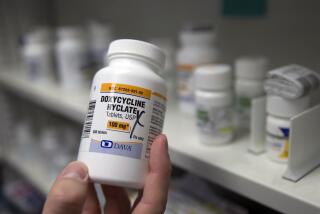National Perspective : Health : Unsafe Sex Practices Traced to Confidence in AIDS Drugs
- Share via
WASHINGTON — The newest AIDS drugs have inspired a false sense of security among gay men, prompting them to engage anew in dangerous sexual behavior, according to several studies released Tuesday at a government-sponsored HIV prevention conference in Atlanta.
One of the studies, conducted among 416 gay men in West Hollywood, found that those who were confident of the drugs’ ability to keep them alive and well were less likely to use condoms or be monogamous than those who had less faith in the medicine. The increased willingness to engage in unsafe sex “could have particularly deadly consequences,” said Sheila Murphy, the USC professor who conducted the study.
Murphy said that, as the growing use of potent new drug combinations has inhibited the effects of AIDS, some gay men “are looking around them and instead of seeing people fade away in a lingering, painful death--as they might have seen 10 years ago--they are seeing people looking healthy and doing well.”
To be sure, such attitudes may change again in light of new statistics released Monday at the conference indicating that the so-called drug “cocktails” may be losing their punch. The drugs produced dramatic declines in the AIDS death rate, starting in 1996, but the rate of the drop slowed considerably in 1998.
At the moment, however, “many gay men no longer see HIV as a serious disease and don’t recognize the dramatic rates at which infection continues to spread in [some] communities,” warned Tom Coates, a researcher with the Center for AIDS Prevention Studies at UC San Francisco.
The evidence in the West Hollywood study of a resurgence of unsafe sex is consistent with other studies released at the conference that showed increasing rates of other sexually transmitted diseases, another way to measure the extent of risky sexual behaviors.
This trend could be “a signal of increases in HIV infection to follow,” said an official with the national Centers for Disease Control and Prevention, which is sponsoring the forum.
For example, in King County, Wash., which includes Seattle, Dr. Hunter Handsfield of the county health department found a sharp resurgence of syphilis during the last two years, especially among gay men.
The infection had been entirely eliminated in the county by 1996. But from the beginning of 1998 through the first half of this year, 88 syphilis cases were reported, with gay men accounting for 85% of the total.
The West Hollywood study, drawn from on-the-street interviews in the latter half of 1997, included 64 HIV-positive men, of whom 52 were taking the new drug combinations. The remaining 352 gay men interviewed were uninfected.
The infected men who were optimistic about the drugs’ ability to keep them healthy used condoms only 66% of the time, compared with 80% for infected men who were less confident about the drugs. Among the uninfected, the optimists used condoms 74% of the time, compared with 85% for those who were less optimistic about the drugs.
“The sense [among the uninfected optimists] was ‘the worst that can happen to me is that I’ll get something I’ll have to take a pill for,’ while [the infected optimists] felt they might be transmitting something that could be treated with medication,” Murphy said.
One potential danger is that those already taking the drugs could unknowingly be transmitting a strain of virus that has become drug resistant, she said.
The study also found that 35% of the infected men who felt reassured about the drug treatments were monogamous, compared with 43% of those who were uneasy about the drugs. Among the uninfected, the numbers were 50% and 59%, respectively.
In other research released during the meeting, which ends today:
* A survey of young gay men 15 to 22 found “alarming levels” of HIV infection (7% overall) and unprotected sex (41%) among nearly 3,500 participants sampled in seven cities, including Los Angeles. The study, conducted by CDC, also found that despite the high level of infection, 35% had never been tested for HIV and only 18% of the infected men knew they were infected.
* A study sponsored by the National Commission on Correctional Health Care found that the prevalence of AIDS infections among inmates in correctional facilities was five times that found in the overall U.S. population and that only 10% of federal and state prison systems and 5% of city and county jails offer comprehensive HIV prevention programs for inmates.
More to Read
Sign up for Essential California
The most important California stories and recommendations in your inbox every morning.
You may occasionally receive promotional content from the Los Angeles Times.













